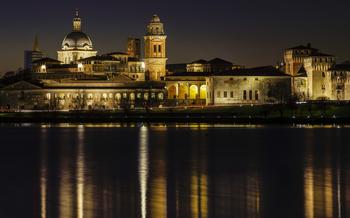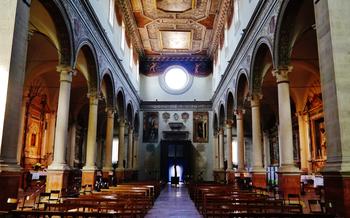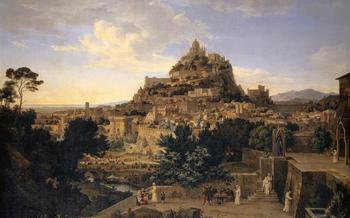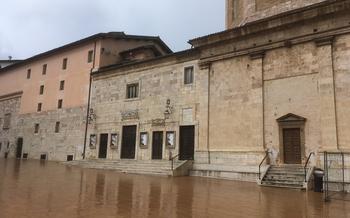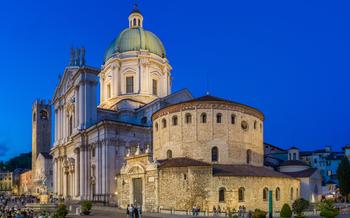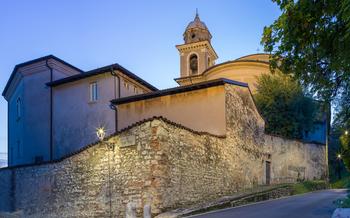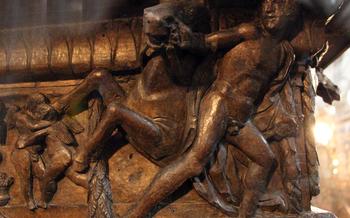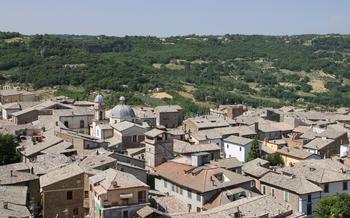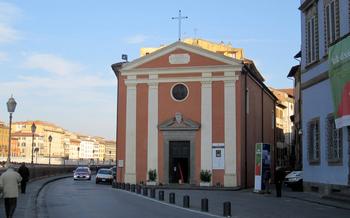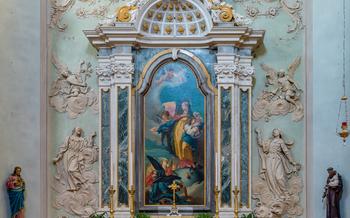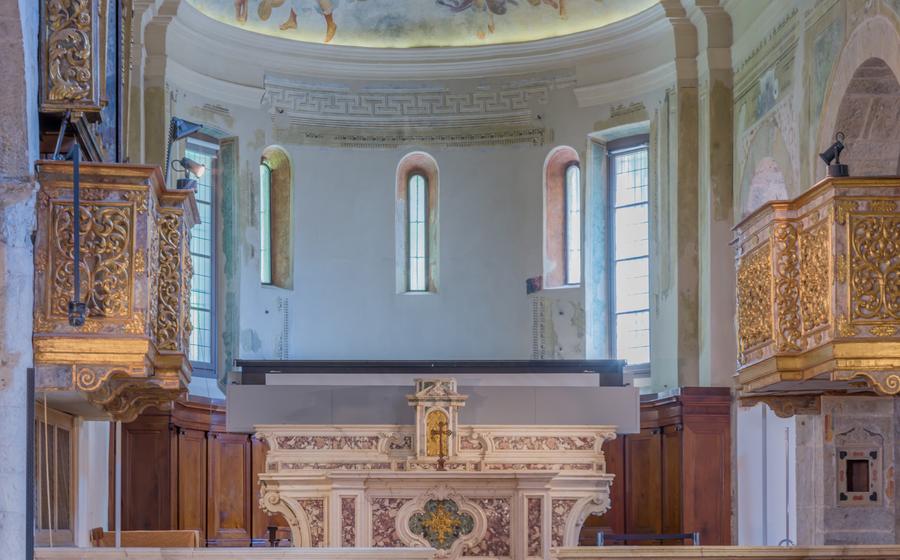
Chiesa di San Giorgio
- Chiesa di San Giorgio: A Sanctuary with Artistic Charm
- Location and Accessibility
- Chiesa di San Giorgio - History and Background
- Exterior Views and Architectural Features
- Stepping Inside San Giorgio - First Impressions
- Exploring the Frescoes - A Visual Masterpiece
- The Apse and its Magnificent Frescoes
- The Nave Aisle Frescoes - Storytelling Through Art
- Discovering the Saints and Prophets
- The Pulpit - A Place of Preaching
- The Organ - Music and Spirituality
- Sacred Relics and Chapels
- Piazza Duomo - The Church's Surroundings
- Insider Tip - The Secret Garden
Chiesa di San Giorgio: A Sanctuary with Artistic Charm
In the heart of Brescia, overlooking the picturesque Piazza Duomo, lies a true architectural treasure—the Chiesa di San Giorgio. This imposing edifice, initially constructed around the 12th century, holds immense historical and cultural significance. Romanesque in style, the church captivates visitors with its graceful lines and intricate details, hinting at the artistic prowess of its creators.
The interior of the Chiesa di San Giorgio is a testament to the artistry and craftsmanship of the Brescian masters. Vivid frescoes adorn the walls and ceiling, narrating biblical tales and the lives of saints with vibrant colors and intricate symbolism. These masterpieces not only beautify the sacred space but also invite viewers to contemplate the profound messages they convey.
The church stands as a monument to medieval devotion, where art, architecture, and faith harmoniously intertwine. Step into the sanctuary and let the stories painted on the walls transport you back in time, instilling a sense of awe and wonder as you witness the glorious heritage of Brescia's storied past.
Location and Accessibility
The Chiesa di San Giorgio stands proudly in the heart of Brescia, overlooking the picturesque Piazza Duomo. Its exact address is Piazza Duomo, 25121 Brescia, Italy. Reaching the church is a breeze, whether you choose to stroll through the charming streets or utilize public transportation.
For those arriving by car, several parking garages are conveniently located within a short walking distance, offering a hassle-free experience. If you prefer to immerse yourself in the local atmosphere, hop on one of the efficient buses that stop right in front of the church, connecting you seamlessly to various parts of the city.
Once you step out into Piazza Duomo, the imposing facade of San Giorgio will captivate your attention. Its strategic position invites you to explore not only the church's artistic treasures but also the vibrant surroundings, including the Duomo Vecchio, the Museo di Santa Giulia, and the lively streets lined with shops, cafes, and restaurants.
Chiesa di San Giorgio - History and Background
The origins of the Chiesa di San Giorgio date back to the 5th century when a small oratory was built on the site. In the 11th century, the church was enlarged and rebuilt in the Romanesque style, which was prevalent in the region at that time. During the 12th and 13th centuries, the church underwent further modifications and expansions, resulting in the incorporation of Gothic elements into its architecture. The most significant transformation occurred in the 14th century when the church was redecorated with the stunning frescoes that adorn its interior. Over the centuries, the Chiesa di San Giorgio has undergone several restorations and preservation efforts to maintain its architectural and artistic integrity. These efforts have ensured that this historic sanctuary continues to captivate visitors with its unique blend of Romanesque, Gothic, and Renaissance elements.
Exterior Views and Architectural Features
The Chiesa di San Giorgio boasts an exterior that is both elegant and captivating. Its facade, although simple in design, exudes a sense of tranquility and harmony. Constructed using locally sourced white limestone, the exterior walls of the church have withstood the test of time, retaining their pristine appearance and delicate carvings. The symmetrical arrangement of windows and doorways adds to the overall visual appeal of the facade, creating a sense of balance and proportion.
One of the most striking features of the exterior is the bell tower, which rises majestically above the surrounding buildings. Its cylindrical shape and tapered design lend it a graceful appearance. The belfry, situated at the top of the tower, houses a set of bells that chime melodiously, marking the passage of time and summoning the faithful to prayer. The tower's exterior is adorned with intricate carvings and decorative elements, showcasing the skill and artistry of the medieval craftsmen who constructed it.
Stepping Inside San Giorgio - First Impressions
As you cross the threshold of the Chiesa di San Giorgio, a palpable sense of awe washes over you. The sanctuary exudes an ethereal ambiance, as if time stands still within its sacred walls. Natural light filters through the stained-glass windows, casting a warm glow upon the interior, illuminating the intricate frescoes that adorn the walls. The air is heavy with the scent of incense, creating a mystical atmosphere that invites contemplation.
Upon entering, your gaze is immediately drawn to the harmonious blend of architectural styles. The church seamlessly merges elements of the Romanesque and Gothic periods, creating a visually captivating space. The soaring vaulted ceilings, supported by robust columns, evoke a sense of grandeur. The transition from the Romanesque nave to the Gothic apse is subtle yet striking, epitomizing the architectural evolution of Brescia's sacred spaces.
Exploring the Frescoes - A Visual Masterpiece
The Chiesa di San Giorgio boasts a remarkable collection of frescoes that adorn its walls and ceilings. These intricate paintings tell captivating stories from the Bible, showcasing the lives of saints and depicting scenes from the history of the church. The frescoes are a true testament to the artistic talent and devotion of their creators, who brought these stories to life with vibrant colors and meticulous detail.
The themes depicted in the frescoes range from the life of Jesus Christ to the trials and triumphs of Saint George, the patron saint of Brescia. The artists used their skills to capture the emotions and expressions of the characters, inviting viewers to connect with the narratives on a deeper level. Each fresco is a masterpiece in its own right, contributing to the overall visual splendor of the church's interior.
The Apse and its Magnificent Frescoes
The apse, the sacred and symbolic space of the church, offers a breathtaking visual experience. Its semi-domed ceiling and curved walls serve as a canvas for a series of remarkable frescoes narrating the life of Jesus Christ. These exquisite paintings, rendered with meticulous detail and vibrant colors, captivate the viewer with their poignant storytelling.
At the center of this celestial tableau, the figure of Christ emerges as the dominant presence. His compassionate gaze and serene countenance exude an aura of divinity. The frescoes surrounding him recount pivotal moments from his earthly ministry, including the Annunciation, the Nativity, the Adoration of the Magi, the Resurrection, and the Ascension.
Interwoven with these biblical scenes are allegorical depictions of virtues and vices, perpetuating medieval theological narratives. The interplay of symbolism and narrative gives the viewer a profound insight into the moral and spiritual lessons that the church sought to convey to its medieval flock.
The artistic style of the apse frescoes blends Byzantine influences with emerging Gothic sensibilities. Fluid lines, expressive gestures, and a vibrant color palette create a sense of movement and drama, enhancing the impact of the narratives.
This harmonious ensemble, combining theological messages with artistic brilliance, makes the apse of the Chiesa di San Giorgio a true masterpiece of medieval art, offering visitors a window into the spiritual world of the Middle Ages.
The Nave Aisle Frescoes - Storytelling Through Art
Venturing into the nave aisle of San Giorgio reveals an exceptional series of frescoes dedicated to the life of Saint George, the church's patron saint. These vibrant and intricate murals narrate the legendary tales of his heroic battles against evil forces. The compelling imagery and vivid colors bring to life the saint's courageous encounters with dragons and his unwavering faith in God.
The frescoes depict key episodes from Saint George's life, including his confrontation with the fearsome dragon that terrorized a village. The scenes showcase his unwavering determination and miraculous victory over the monstrous creature. The artistic portrayal of these battles symbolizes the eternal struggle between good and evil, highlighting Saint George's role as a champion of righteousness and a protector of the faithful.
Each fresco serves as a visual testament to Saint George's extraordinary feats, inviting viewers to immerse themselves in the stories of bravery, sacrifice, and divine intervention. The narrative style of the frescoes allows visitors to follow the saint's journey, witnessing his triumphs and understanding his significance as a symbol of hope and protection.
Discovering the Saints and Prophets
The interior walls of Chiesa di San Giorgio are adorned with frescoes depicting various saints and prophets, each holding a unique place in the church's iconography. These holy figures, easily recognizable by their halos and distinctive attributes, serve as celestial guides and protectors, representing the rich tapestry of Christian faith.
Among the most prominent saints featured are Saint Anthony the Abbot, known for his eremitic lifestyle and patronage of lost things, and Saint Francis of Assisi, the beloved founder of the Franciscan order, renowned for his humility and love for nature. Their presence in the church reflects the deep devotion to these revered saints, whose lives and teachings continue to inspire believers.
The frescoes also showcase Old Testament prophets, such as Isaiah and Jeremiah, who played a pivotal role in conveying God's messages to humankind. Their inclusion emphasizes the continuity between the Old and New Testaments, highlighting the shared spiritual heritage and the enduring significance of their prophecies.
Each fresco is a testament to the artistic skill and theological knowledge of the medieval painters who created them. The saints and prophets are depicted with intricate details, capturing their expressions, gestures, and the stories they represent. These frescoes serve as a visual reminder of the rich spiritual legacy that permeates the walls of Chiesa di San Giorgio, inviting visitors to contemplate the lives and teachings of these holy figures.
The Pulpit - A Place of Preaching
In the heart of the Chiesa di San Giorgio, the pulpit stands as a testament to the church's rich history and spiritual significance. Constructed in the 15th century, this elevated platform served as a focal point for delivering sermons and religious teachings to the faithful.
Crafted from precious marble, the pulpit captivates with its intricate carvings and decorative elements. The skilled artistry displayed in its design reflects the importance placed on the spoken word within the church.
Symbolism abounds in the pulpit's design, with each element carrying profound meaning. From the intricately carved figures of saints and prophets to the allegorical representations of virtues, every detail contributes to a harmonious and visually engaging narrative.
The pulpit's placement within the church is both strategic and symbolic. Positioned to command attention, it allowed the preacher to engage directly with the congregation, fostering a sense of community and spiritual connection.
Whether marveling at its artistic beauty or contemplating its religious significance, the pulpit in the Chiesa di San Giorgio stands as a powerful symbol of the church's enduring legacy as a center of faith and contemplation.
The Organ - Music and Spirituality
The Chiesa di San Giorgio proudly houses a magnificent organ, a testament to the fusion of music and spirituality within its sacred walls. This historical instrument, with its impressive array of pipes, has played a pivotal role in enhancing religious ceremonies and creating an atmosphere of devotion for centuries.
Crafted with meticulous precision and adorned with intricate carvings, the organ is a masterpiece of craftsmanship, reflecting the artistic and spiritual values of the church. Its sonorous tones reverberate through the grand interior, captivating the senses and elevating the hearts and minds of worshippers.
The organ's origins can be traced back to the early Renaissance period, when it was first introduced to churches as a means of enriching liturgical music. The instrument gained prominence in Brescia, becoming an integral part of the city's rich musical heritage.
Over the years, the organ has undergone restoration and maintenance to ensure its longevity and preserve its original beauty. The dedication of skilled artisans and organ builders has contributed to its continuous functionality, allowing it to continue gracing the church with its celestial melodies.
Sacred Relics and Chapels
The Chiesa di San Giorgio proudly enshrines sacred relics of saints, each holding immense religious significance. These relics, believed to possess a divine presence, serve as a tangible connection to the lives and sacrifices of holy figures. Visitors can pay their respects and seek spiritual guidance at the chapels dedicated to these revered saints.
The artistry within the chapels is equally captivating, adorned with symbolic representations and intricate details that narrate the stories of the saints. These chapels become sacred spaces where devotees engage in devotional practices, prayers, and rituals, seeking blessings and divine intervention. The atmosphere within these chapels is one of profound reverence and spirituality, inviting visitors to reflect upon their own faith and connection to the divine.
Piazza Duomo - The Church's Surroundings
Piazza Duomo, the square surrounding the Chiesa di San Giorgio, is a vibrant hub of religious, historical, and cultural significance. Bordered by elegant buildings, the piazza creates a harmonious backdrop for the majestic church.
At its center, a towering monument dedicated to fallen soldiers stands as a solemn testament to the sacrifices made during wartime. The square's cobblestone pavement adds a touch of antiquity, while the manicured gardens offer a tranquil respite from the city's bustling streets.
Over the centuries, Piazza Duomo has witnessed countless religious processions, festivals, and public events, cementing its role as the heart of Brescia's spiritual and cultural life. It's a place where history unfolds, traditions are preserved, and the spirit of the city thrives.
Insider Tip - The Secret Garden
Amidst the bustling city, the Chiesa di San Giorgio holds a hidden treasure—a secret garden. Nestled discreetly behind the church, this serene sanctuary offers a tranquil respite from the vibrant streets of Brescia. To find this hidden gem, one must venture through a discreet doorway, leading to a secluded courtyard. The garden unfolds, revealing a verdant oasis adorned with fragrant flowers, lush greenery, and a murmuring fountain.
This enchanting space invites visitors to pause and reflect amidst the beauty of nature. Its serene atmosphere provides a contemplative backdrop for introspection and spiritual connection. The garden's symbolism is profound, representing the spiritual growth and transformation that can occur within the sacred space of the church. It serves as a reminder that even amidst the hustle and bustle of city life, moments of tranquility and communion with nature can be found, offering solace and rejuvenation to weary souls.
